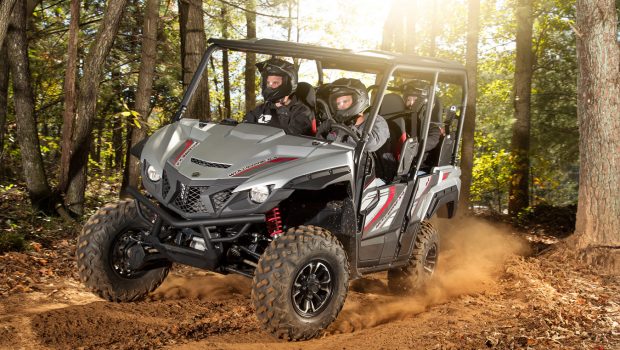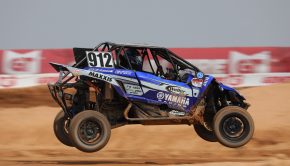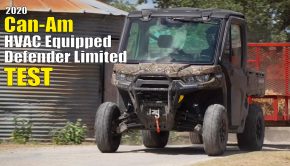2018 Yamaha Wolverine X4 Test Review: WITH VIDEO
We test Yamaha’s new 4-seat, sport/utility, adventure machine.
For 2018, Yamaha is launching their second entry into the Sport/Utility segment with the introduction of the new, from the ground up Wolverine X4. According to Yamaha, “The Wolverine X4 is designed to be the most capable 4-seat recreational SxS delivering superior performance in tight technical terrain.” Yamaha tells us that the car was developed to fill the needs of customers prioritizing terrain conquering capability, durability, comfort, a compact feel, and utility function capability. With Fall colors setting in, we were given the opportunity to put the machine through a day of testing on the twisty mountainous trails of Brushy Mountain Motorsports Park located in the Brushy Mountains in North Carolina, which proved to be the perfect place to show off the Wolverine X4.
Engine
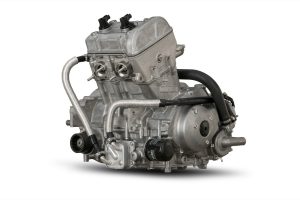
a brand new 847cc, fuel-injected, parallel twin, featuring four valves and double overhead cams per cylinder. The engine is said to produce 69hp, and Yamaha claims that torque is up a whopping 47% compared to the Wolverine R-Spec’s 708cc single-cylinder engine.
To power the X4, Yamaha developed a brand new 847cc, fuel-injected, parallel twin, featuring four valves and double overhead cams per cylinder. The engine is said to produce 69hp, and Yamaha claims that torque is up a whopping 47% compared to the Wolverine R-Spec’s 708cc single-cylinder engine.
To provide smooth power and maximize traction, Yamaha developed a long-stroke engine design. Yamaha wanted to run shorter connecting rods with shorter cylinders to better centralize mass without sacrificing engine longevity. They accomplished this by offsetting the cylinders, minimizing side load on the piston during the power stroke.
A drive-by wire system further smooths power delivery by measuring speed, throttle position, and a number of other factors to help filter out gas pedal bob in technical terrain. Fuel is fed to the engine by a Mikuni fuel injection system with dual 36mm throttle bodies.

The top end mates up to a Yamaha Ultramatic CVT style transmission, developed specifically for the new engine. The transmission features dual forward ranges plus neutral and reverse.
The top end mates up to a Yamaha Ultramatic CVT style transmission, developed specifically for the new engine. Yamaha’s transmission features a clutch to handle engagement and disengagement providing constant drive belt tension for superior durability. A one-way sprag clutch provides engine braking to all four wheels in four-wheel-drive. The transmission features dual forward ranges plus neutral and reverse, accessed by a gated shifter. The zero compromise drive system features selectable two-wheel-drive, four-wheel-drive, and four-wheel-drive with front differential lock.

In twisty mountainous terrain, we feel this is the most well-rounded and capable engine in Yamaha’s side-by-side lineup. Power delivery doesn’t come much smoother although the twin-cylinder design revs out fast enough to keep the occupants entertained
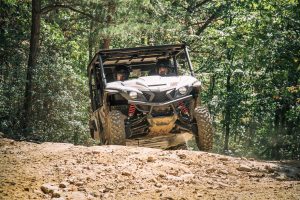
Driving into the face of a moderate incline, the engine doesn’t seem phased as it happily growls along sounding untaxed.
In twisty mountainous terrain, we feel this is the most well-rounded and capable engine in Yamaha’s side-by-side lineup. Power delivery doesn’t come much smoother although the twin-cylinder design revs out fast enough to keep the occupants entertained for days. Yamaha’s decision to build a high-torque engine pays off any time the trail turns upward. Driving into the face of a moderate incline, the engine doesn’t seem phased as it happily growls along sounding untaxed. Unless you’re towing massive weight or simply picking your way through a section at a snail’s pace, low-range doesn’t ever seem necessary. When you reach the downside of a hill, engine braking is as smooth on the way down as acceleration is on the way up.
As the terrain opens up, the Wolverine is happy to cruise along or rip down straightaways. The twin offers plenty of power and responsiveness to race out of turns, power out of G-outs, and preload for a little air. Although we never reached top speed, we’re told it’s in the 50mph range. Reaching the mid 40s on a few occasions, it feels like there is plenty of power in reserve.

The large air box and filter, which can be accessed without tools, are mounted high under the hood keeping intake noise away from the occupants. The intake system was designed to be rigid reducing noise from vibration.
The engine sits low in the center of the car to maximize mass centralization for light, nimble handling. Larger rubber motor mounts and a gear-driven counter balancer are both used to minimize vibration, which isn’t an issue.
To minimize noise, Yamaha used a high volume muffler on the X4, which is whisper quiet at idle. The intake system was designed to be rigid reducing noise from vibration. The large air box and filter, which can be accessed without tools, are mounted high under the hood keeping intake noise away from the occupants. Also located under the hood is the removable speed limiting key, which limits the machine’s top speed to 25mph without limiting horsepower for towing or climbing. Other noise reducing features include an insulated console, a helical/spiral gear designed to reduce drivetrain noise, and the CVT upshifts at lower RPMs to keep the engine running quieter, which should also conserve fuel. At idle, the engine is whisper quiet. Cruising the trails, you can still enjoy the mild roar of the engine while having a conversation without screaming. Interior sound levels seemed equally pleasant front or rear.
Overall, the engine performs quite well for the machine’s intended use. If you’re a performance junkie like us, there’s likely even more pep to be had with a little clutch tuning.
Chassis and suspension
To provide superior performance in tight terrain, Yamaha gave the X4 pretty compact dimensions for a 4-seat SxS. Its 82.7” wheelbase and 122” overall length lies between the Honda Pioneer 1000 5 and Kawasaki Teryx4. Its 59.8” overall width is 8/10” narrower than the Teryx 4, which is narrower than the Pioneer. Both the Polaris General 4 and Can-Am Commander Max feature wheelbases well over 100” leaving them more focused on wide-open terrain.

To provide superior performance in tight terrain, Yamaha gave the X4 pretty compact dimensions for a 4-seat SxS.
During manufacturing, the Frame is fully submerged in an E-coat tank to help prevent internal rusting; then the frame is powder coated. Protecting the entire underside of the frame is a combination of welded on steel plates with access points for maintenance and a removable front plastic skid plate.

The suspension consists of dual control arms at both ends with wide-arc lower A-arms up front for improved clearance. The gas-charged front shocks feature 5-way preload adjustment with non-adjustable, self-leveling shocks out back.
The suspension consists of dual control arms at both ends with wide-arc lower A-arms up front for improved clearance. The gas-charged front shocks feature 5-way preload adjustment with non-adjustable, self-leveling shocks out back. They’re designed to automatically maintain the correct rear ride height and 10.7” of ground clearance regardless of occupants or cargo. They accomplish this utilizing proven technology from the automotive world. The shocks self-adjust as they compress and extend a few times after the load has changed using check valves and different oil chambers to maintain their pre-prescribed ride height so there are no computers or electronics to worry about. Suspension travel numbers are competitive in the compact 4-seat segment with 8.7” front and 8.9” rear. Electronic power steering comes standard on all Wolverine X4 models offering Yamaha’s typically good balance of light steering and bump absorption, while still leaving you feeling connected to the trail.

The rear shocks are designed to automatically maintain the correct rear ride height and 10.7” of ground clearance regardless of occupants or cargo.
The X4 rolls on a set of exclusively purposed 26” Maxxis tires, 4 ply front and 6 ply rear, which come mounted on 12” cast aluminum wheels on all models except the Graphite base model, which uses steel wheels.
We entered the test underestimating the Wolverine’s handling and suspension. The ride is pretty plush, eating up square edged hits without feeling willowy or vague. Using 12” wheels instead of 14s creates a taller tire sidewall adding to small bump compliance and helping to reduce the chance of a pinch flat.
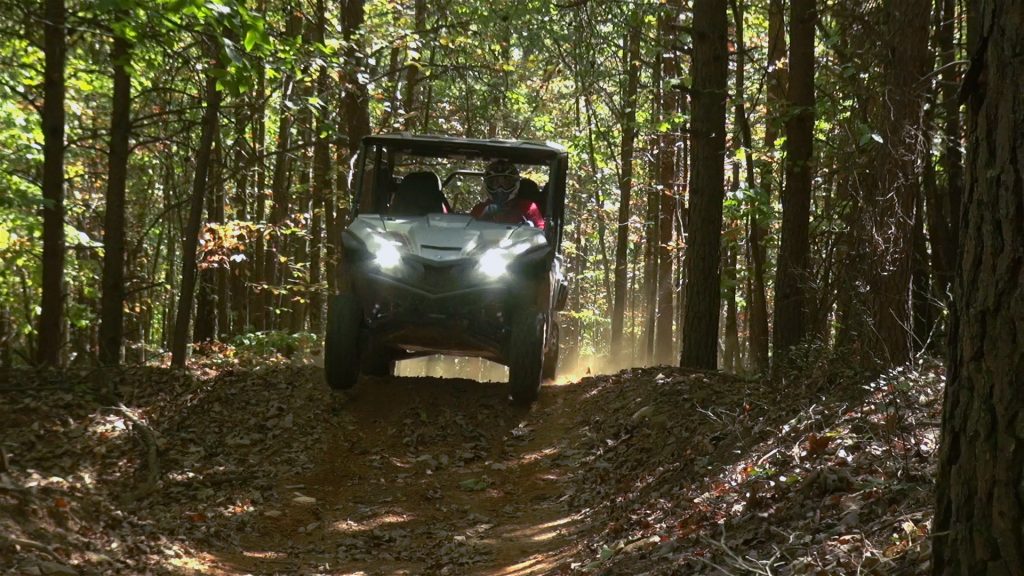
The ride is pretty plush, eating up square edged hits without feeling willowy or vague. For those holes, hits, and G-outs that were a little bigger than expected, the X4’s shocks offer a good amount of bottoming resistance
For those holes, hits, and G-outs that were a little bigger than expected, the X4’s shocks offer a good amount of bottoming resistance. Reaching the end of the travel on a couple of occasions, the shocks never emitted a hard metal-to-metal sensation. The rear end bounced a bit landing from a little air, but nothing serious. We suspect that pounding whoops may be a bit out of the car’s element. On the ground, the suspension is well composed from top to bottom and ideal for the terrain we tested in.

Steering accuracy is good at low speeds, pushing a bit when you charge corners hard in 2wd. We preferred driving hard in limited-slip 4wd. With the front tires pulling you through turns
Equipped with sway bars at both ends with its engine sitting low in the center of the vehicle, the Wolverine doesn’t roll excessively in corners and feels pretty predictable on sidehills. Steering accuracy is good at low speeds, pushing a bit when you charge corners hard in 2wd. We preferred driving hard in limited-slip 4wd. With the front tires pulling you through turns, you can drive hard with good steering accuracy. The car may also benefit from adding a touch more toe-in.
Maneuverability was quite good. Turning around was pretty easy in spite of a lack of cross trails. We were easily negotiating tight switchbacks that would have had us performing a number of four-point turns in the General 4 or Commander Max.
Ground clearance is on the shorter end for the class, yet we rarely framed out. In the intermediate to dry conditions, we faced on the rock strewn, clay-based trails, the tires performed well, although we weren’t much in the way of mud available for testing. Flats didn’t seem to be a common occurrence either.
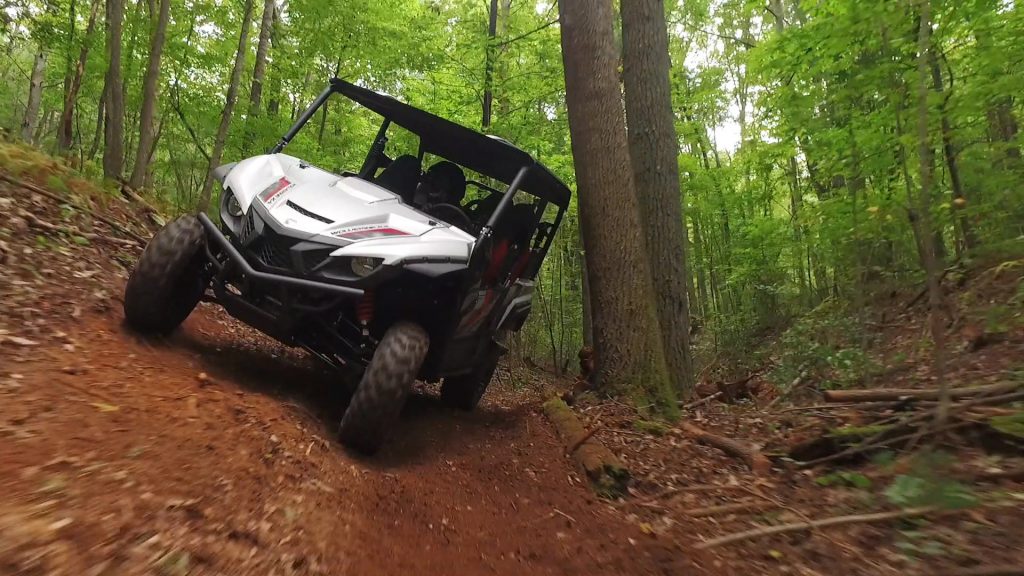
Equipped with sway bars at both ends with its engine sitting low in the center of the vehicle, the Wolverine doesn’t roll excessively in corners and feels pretty predictable on sidehills.
Brakes
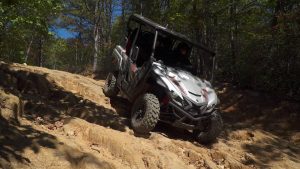
Remembering the X4’s sporty intentions, Yamaha wisely equipped the machine with hydraulic disc brakes at all four wheels. They feature 207mm rotors and dual piston calipers all around.
Remembering the X4’s sporty intentions, Yamaha wisely equipped the machine with hydraulic disc brakes at all four wheels. They feature 207mm rotors and dual piston calipers all around. Stopping power was not an issue and the brakes offered good feel and modulation through the pedal.
Utility
Rated to tow a full ton, the Wolverine X4’s rated tow is 500-800 pounds more than most of its four-seat sport/utility rivals including the Polaris General 4 and Can-Am Commander Max, equaled only by the Honda Pioneer 1000 5. With a full-size, 2” hitch receiver, the X4 allows you the convenience of being able to borrow the hitch from your truck.
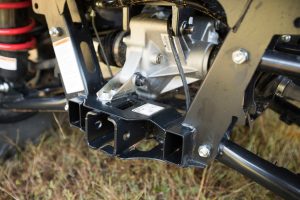
Rated to tow a full ton, a full-size, 2” hitch receiver allows you the convenience of being able to borrow the hitch from your truck.
A tailgate provides easy access to the bed, which is rated to haul 600lbs, more than enough for coolers, tents, and some fishing poles. With the rear seats taking up a majority of the potential cargo bed space to allow for a more compact machine, the rear seats can be slid forward opening up significantly more room for cargo, offering more space than the Teryx4 while retaining full-size seats unlike the Honda Pioneer. We would like to see a drop-in bed liner helping keep small items or debris in place while protecting the rear seat rails.

A tailgate provides easy access to the bed, which is rated to haul 600lbs. The rear seats can be slid forward opening up significantly more room for cargo. We would like to see a drop-in bed liner helping keep small items or debris in place while protecting the rear seat rails.
Interior and Other Details

Front occupant space is similar to the Wolverine R-Spec with plenty of space for 6’ tall occupants. High backed seats are used all around, offering some bolstering and are pretty soft and comfy.
The cockpit features new, higher profile doors than those used on the two-seat Wolverine, leaving us speckle free after hitting the few small mud holes we encountered. Stepping in the front is easy, although the smallish rear doors and rear bodywork require a touch more effort for back seat occupants to enter.
Front occupant space is similar to the Wolverine R-Spec with plenty of space for 6’ tall occupants. High backed seats are used all around, offering some bolstering and are pretty soft and comfy. The driver’s seat features an automotive style sliding adjustment system. Tilt steering offers 12” of adjustment. The rear seats are mounted almost 4” higher for improved visibility. Rear leg room is a bit limited, especially side to side due to the engine’s placement. This might not be an issue for young riders, but you notice it wearing size 12 boots. On the flip side, the X4’s rear passenger area is the most secure feeling we’ve experienced, thanks, in part, to the shoulder bolsters for all occupants, comfortable anti-cinch seat belts, and somewhat cozy space.
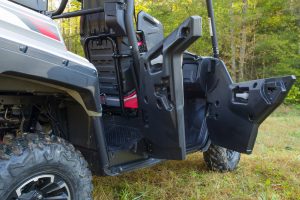
The cockpit features new, higher profile doors than those used on the two-seat Wolverine. The smallish rear doors and rear bodywork require a touch more effort for back seat occupants to enter.
A dimmable LCD display helps you keep track of speed, distance, fuel, and other useful info. The glove box and center console offer a good amount of dry storage. There are plenty of drink holders with two up front and four in the back. LED head and taillights should offer plenty of visibility for night drives.
Accessory Customization
Yamaha will be offering accessories from basic essentials like winches and rock sliders all the way up to building the X4 into a fully enclosed vehicle. The hard enclosure features an automotive glass windshield, windshield wipers, sliding windows, and lockable doors. There’s an optional headliner with integrated speakers, optional light bar, optional mirrors, and much more. Yamaha is even ready to go with plows and track systems. Basically, the Wolverine can be turned into a year-round machine for play and work.

Yamaha will be offering accessories from basic essentials like winches and rock sliders all the way up to building the X4 into a fully enclosed vehicle.
Conclusion
Yamaha’s Wolverine X4 is a great machine for exploring wooded trails and weekend camping trips in the wilderness. Its expansive, well integrated line of accessories make it one of the most versatile side-by-sides on the market.
Priced from $15,999 up to $17,249 for the Matte Carbon and Matte Silver Special Edition models, the Wolverine X4 is competitively priced. The Wolverine X4 plays hard while retaining the ability to get work done without too much compromise. Its sporting performance kept us smiling while its comfortable ride and interior had us wishing the day was a little longer.
View full specifications, pricing, and more at https://www.yamahamotorsports.com/

Yamaha’s Wolverine X4 is a great machine for exploring wooded trails and weekend camping trips in the wilderness. Its expansive, well integrated line of accessories make it one of the most versatile side-by-sides on the market.
2018 Yamaha Wolverine X4 Test Ratings
Summary: Yamaha’s Wolverine X4 is a great machine for exploring wooded trails and weekend camping trips in the wilderness. Its expansive, well integrated line of accessories make it one of the most versatile side-by-sides on the market.

